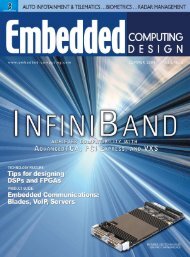Technologic - OpenSystems Media
Technologic - OpenSystems Media
Technologic - OpenSystems Media
- No tags were found...
You also want an ePaper? Increase the reach of your titles
YUMPU automatically turns print PDFs into web optimized ePapers that Google loves.
OpenCL has been used in both of these projects to maximizethe GPU compute resources available within the APU. In x264,the quality optimizations associated with the lookahead functionwere ported completely to OpenCL on the GPU. This canbe used in transcoding applications to improve the outputvideo quality and normally consumes up to about 20 percent ofCPU time. Handbrake uses x264 directly as the video encoder.In addition, Handbrake uses OpenCL to perform video scalingand color space conversion from the RGB to YUV color space.AMD’s hardware video decoder (UVD) was also used inHandbrake to perform some of the video decoding tasks.Data was produced on a Trinity 100 W A10 desktop machine;however, the underlying architecture is identical to that used inthe embedded product.Figure 1 | A high-level view of the AMD R-Series APUarchitecture shows a common memory controller between thearray of SIMD processing elements and x86 cores.Handbrake A10 5800K (100 W TDP) CPU GPUFrequency (GHz) 3.8 0.8Cores 4 384FLOPS/core 8 2GFLOPS 121.6 614.4A10 5800K total GFLOPS 736A10 5800K power (W TDP) 100Table 1 | A comparison of operating parameters demonstratesCPU versus GPU performance in an AMD desktop part.One example of a data-parallel application is Handbrake, awidely used video transcoding utility that runs on a variety ofoperating systems and hardware platforms. The utility is notablein that it has well-integrated multicore support and thereforeserves as an appropriate platform to study the effectivenessof multicore strategies. Handbrake uses x264, a full-featuredH.264 encoder used in several open-source and commercialproducts that provide adequate multicore support.To simplify analysis of the APU’s complex power managementarchitecture, the top Thermal Design Power (TDP) was evaluatedinstead of breaking out the power consumed by eachsubsystem. The data displayed in Table 2 shows that whenprocessing is performed purely in the CPU, a 14.8 fps framerate is achieved, and processing is accomplished in 62 seconds.Involving the GPU and UVD blocks in the processing increasedthe frame rate to 18.3 fps, reducing processing time and hencepower consumption by 14 seconds or 22 percent.The floating-point operations total in Table 2 is the product ofthe floating-point throughput from Table 1 and the processingtime, from which can be drawn a figure of merit: operations perwatt. Looking at the total floating-point operations and normalizedoperations per watt, it becomes clear that processingresources are being left on the table. CPU-only throughputis 75 operations per watt, while it is boosted to 353 operationsper watt when the GPU is added for an improvement intheoretical floating-point throughput of nearly 5x (4.7).Twenty-two percent is nontrivial savings, but while this generationof APU makes significant progress in the direction of HSA,all memory accesses are not uniform from the standpoint oflatency and throughput. When the kernel accesses memory,it does so directly. Such operations occur at a theoretical rateof 22 GBps or 16 to 18 GBps in typical applications. When abuffer is created in host memory to access GPU data, however,that data goes through a different path where the effectiveHandbrake A10 5800K (100 W TDP)High preset, 1080p input transcoded to 720p 6 Mbps outputNo GPU GPU used + UVD Difference14.8 fps 18.3 fps 3.5 fps62 sec 48 sec -14 secFloating-point operations total (x10^6) 7,539.2 3,5328 27,788.8Operations/watt 75.392 353.28 277.888Table 2 | An analysis of a Handbrake application on an A10 desktop machine shows the performance difference when using a CPU aloneversus using a GPU and UVD blocks for processing.www.embedded-computing.com Embedded Computing Design December 2012 | 21
















